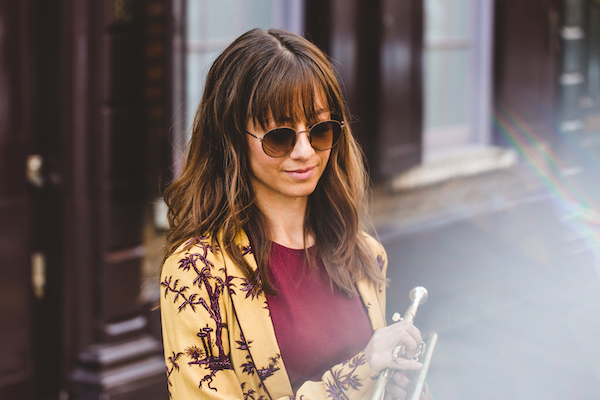Oct 28, 2025 10:47 AM
In Memoriam: Jack DeJohnette, 1942–2025
Jack DeJohnette, a bold and resourceful drummer and NEA Jazz Master who forged a unique vocabulary on the kit over his…

Trumpeter and flugelhornist Yazz Ahmed celebrates the accomplishments of others on Polyhymnia, a work released through the Ropeadope imprint.
(Photo: John Jarrett)Polyhymnia is a clear demonstration that Yazz Ahmed’s global awareness and pursuit of thought-provoking music hasn’t waned. Having shown herself to be a model of mindfulness on 2017’s La Saboteuse, the London-based trumpeter and flugelhorn player now turns her attention to the accomplishments of others.
Unconventional percussion, complex rhythms and intricate but billowy melodies blend on Polyhymnia (Ropeadope) to convey the strength of women across generations, cultures and personal callings—individuals who have made vital contributions to the world. Even the album title bears the name of a strong female figure: the Greek muse of music, dance and arts.
Whether encouraging empowerment through colorful musicality or showcasing the bravery and tenacity of figures likes Ruby Bridges and Malala Yousafzai, Ahmed’s latest album reflects both her artistic prowess and a respect for vibrant storytelling.
The following has been edited for length and clarity.
Each track on Polyhymnia sounds like an active character, rather than a passive backdrop supporting a narrative. How did your affinity for sound design come into play when you were shaping the songs’ sonic personalities?
It’s quite a complicated process. So, obviously I wrote all the music and recorded everything I’d written. And then came the sort of added layers and bits of electronics, all sorts of little things I wanted to add to bring out the pieces and the characteristics of the players. And the moods where the journey goes in each piece, you know, reflecting the narrative. So, things I did—for example, in “2857,” which is dedicated to Rosa Parks—I used a sort of low rumbling sound in the tenor cadenza, which I suppose, sounds a bit like a bus. But it’s also this sort of deep layer of unsettling sounds that kind of set up the next section where it’s all very free and angry, and very groovy as well.
I think what really helps is that with jazz, you have the freedom to improvise and that lets you express yourself—to try and tell your story or your views through freedom of expression. All the musicians [on Polyhymnia], they knew the stories behind each piece, so I think that really helped with their contributing to the music through improvisation.
On the front half of the album, you give your trumpet a warmer, rounded tone, despite telling stories about women cutting through barriers. What was your thought process for choosing that over a more piercing sound that might symbolize the kind of action taken by the people you’re celebrating?
For me, as a trumpet player, I want to try and make the best sound I can—whatever the situation. But then for these individual pieces, what I thought about was how to represent the women through improvisation. I added electronic effects to some of the pieces to create something maybe a bit harsher than how I’d normally play. Or something a bit more distinct, something different.
I would use my Kaoss Pad to make strange kinds of bubbly sounds. Or again, on “2857,” I would create distorted sounds on my trumpet, so it has that harsh quality; at the same time I’m sampling myself on the Kaoss Pad with a very high pitched, bite-y sound. But yeah, most of the time I like to create a warm sound that I hope surrounds the listener and makes them feel like a blanket is being wrapped around them.
Given the sentiments of empowerment on Polyhymnia, what does it mean for you to be able to write music with such open messages, knowing that free speech and women’s rights are still delicate affairs in Bahraini society?
So, I’m half Bahraini, half English. My father is Muslim, my mom has no religion; she’s an atheist. I grew up in Bahrain until I was nine and my memories are very happy memories of playing outside a lot, going swimming, riding my BMX in the desert, good food, good music, and fun with the family. So, I didn’t notice any prejudices at that time. And I went to an international school, so I grew up with people from all over the world. I lived, I suppose, quite a sheltered life.
When I moved to the U.K., I started to learn about these things, really, from my sisters who look sort of more [stereotypically] Arabic than I do. They’d be called quite nasty names, and we’d never heard these words before, so that’s how I learned that maybe it’s not a good idea to say my father is Muslim. I denied my cultural background for a long time, and then when I reached my early 20s, I took ownership of my mixed heritage and realized it’s something I should be proud of. It made me feel like a whole person again.
I know there are a lot of preconceptions about Arab women and I think some people might expect that my Bahraini family might not be so approving of what I do. The interesting thing is that they do approve. First of all, they couldn’t understand why I’d be a musician, because a lot of people from Bahrain, they’re very business-minded. So, [my family] are like, “Well how do you earn money?” It’s nothing to do with, “Well I’m a woman and I shouldn’t be on stage.”
Then when I went to play in Bahrain last year, I met the Minister of Culture, who’s a woman, and she was saying, “We’re all so proud of you—a Bahraini woman, traveling the world and representing Bahrain.” But then again, Bahrain is quite liberal compared to lot of countries in the Middle East. A lot of them are quite conservative and restrictive. Saudi Arabia is a good example of that. So, that’s one of the reasons I really admire Haifaa Al-Mansour. She’s a Saudi film director who’s fought against the conservative nature of that country. I just hope that I’m changing people’s perceptions of people from the Middle East and people of Muslim heritage.
How’s London’s scene, given that the industry still struggles with recognizing women and their accomplishments?
Hopefully, it’ll be a nice surprise for listeners who buy the physical [copy of Polyhymnia,] because when you look at the musicians involved, the majority of them are women, which I hope will change people’s minds about women players.
It’s very difficult as a women and any sort of minority, I think, to make a voice in jazz. So, it’s taken me a long time to get my voice heard. And [I’ve had] a lot of confidence issues, trying to be a young musician competing with the boys at an age where they’re stereotypically very macho, and it’s all about who can play the highest, the fastest, the loudest.
In the U.K., there are a lot of organizations that are trying to make a difference and support young female jazz musicians, and I very luckily went on this artist development program—I was selected for it. It’s called Take Five, and it’s with an organization called Serious. That opened my eyes and helped me; they helped to nurture me.
There’s another organization called Tomorrow’s Warriors, who are fantastic. They educate, nurture and they give out opportunities to minorities that might not have [access to them] normally.
This is another problem: If we don’t see minorities, things aren’t going to change. For example, when I was growing up, I didn’t have anyone to look up to in the jazz world. All I knew were men—and I loved the guys I listened to. But there were no women, and it kind of made me feel like, well maybe women don’t become jazz trumpet players. But I did find Ingrid Jensen, who is a real role model to me. But yeah, just finding that one person gave me the confidence and drive to keep working and become a professional musician. There are a lot of stories being missed, if we’re not representing other voices. I see things are getting better. I think it’s all about normalizing and seeing people, seeing women, seeing people from other [backgrounds] playing music. I think that will start a chain reaction. DB

Jack DeJohnette boasted a musical resume that was as long as it was fearsome.
Oct 28, 2025 10:47 AM
Jack DeJohnette, a bold and resourceful drummer and NEA Jazz Master who forged a unique vocabulary on the kit over his…

D’Angelo achieved commercial and critical success experimenting with a fusion of jazz, funk, soul, R&B and hip-hop.
Oct 14, 2025 1:47 PM
D’Angelo, a Grammy-winning R&B and neo-soul singer, guitarist and pianist who exerted a profound influence on 21st…

To see the complete list of nominations for the 2026 Grammy Awards, go to grammy.com.
Nov 11, 2025 12:35 PM
The nominations for the 2026 Grammy Awards are in, with plenty to smile about for the worlds of jazz, blues and beyond.…

Drummond was cherished by generations of mainstream jazz listeners and bandleaders for his authoritative tonal presence, a defining quality of his style most apparent when he played his instrument unamplified.
Nov 4, 2025 11:39 AM
Ray Drummond, a first-call bassist who appeared on hundreds of albums as a sideman for some of the top names in jazz…

Jim McNeely’s singular body of work had a profound and lasting influence on many of today’s top jazz composers in the U.S. and in Europe.
Oct 7, 2025 3:40 PM
Pianist Jim McNeely, one of the most distinguished large ensemble jazz composers of his generation, died Sept. 26 at…






